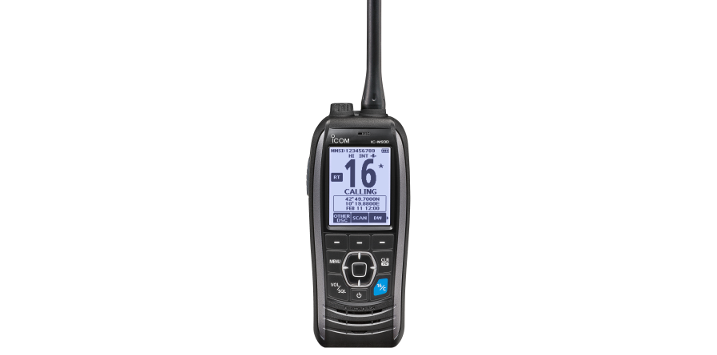SPONSORED ARTICLE

Icom provides an overview of handheld DSC radios and why they are an important communication tool.
One of the gadgets to hit marine chandlers in recent years is the handheld DSC radio; they are an extension of their fixed variants that have been around for the last decade providing a wider range of users with an extra level of safety at sea.
With the increase of small boat owners taking to UK waters, including; kayakers, jet-skiers, dinghy sailors and paddleboarders a specification was developed by the marine industry that would allow these new users to have a portable VHF/DSC device.
A DSC handheld radio works just like a standard VHF handheld, but with a couple of additions. A DSC handheld such as the IC-M93D has a red emergency button on the back. By pressing and holding the button for 3 seconds, you can send an emergency distress signal to other vessels equipped with DSC radios such as the Coastguard. If you have time, you can select the type of emergency from an on-screen list of options. The screen will confirm that the help message with your coordinates has been sent, and then automatically switch the radio to Channel 16, where rescuers will try to contact you by voice.
DSC radios aren’t just for emergencies. They are also useful for group communications. Maritime Mobile Service Identity (MMSI) numbers of other DSC radios can be entered and stored in your radio’s address book. Select a name from the address book of someone you want to call; each name has a corresponding MMSI number. His or her radio will start ringing with an alert tone and automatically switch to the same channel as your radio. You can start chatting. If you and other members of your group are monitoring Channel 16, you don’t have to first hail one another on 16 and then switch to another channel.
You can also request the position coordinates of any radio listed in the address book. If in range, the other radio will reply by showing its latitude, longitude, distance and bearing on your radio’s screen. The radio can also serve as a GPS and indicate a course to the other DSC-equipped unit. (NB: DSC does not provide continuous tracking, so if the other radio is moving, you’ll need to make multiple position requests to get the current coordinates.)
Handheld DSCs have their own, unique MMSI number format. Because handheld DSC’s can be carried from ship to ship, they must not be programmed with a ship’s MMSI. Anyone who already holds a Ship Portable Radio Licence can go onto the OFCOM website and simply add VHF DSC handheld to their list of equipment. Licences are free of charge if issued online.
Icom UK has produced a microsite http://www.dschandheld.com dedicated to handheld DSC radios. It gives an overview of what DSC Handheld VHF radios are, where they can be used and why boat owners need one.
For more details about Icom and its broad range of marine radio and AIS solutions visit: https://www.icomuk.co.uk/Marine_Radio